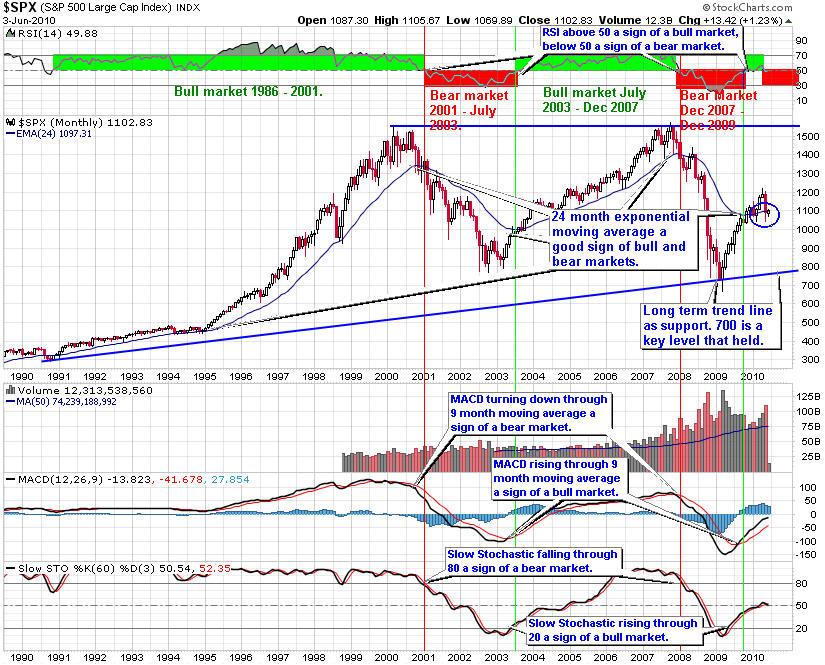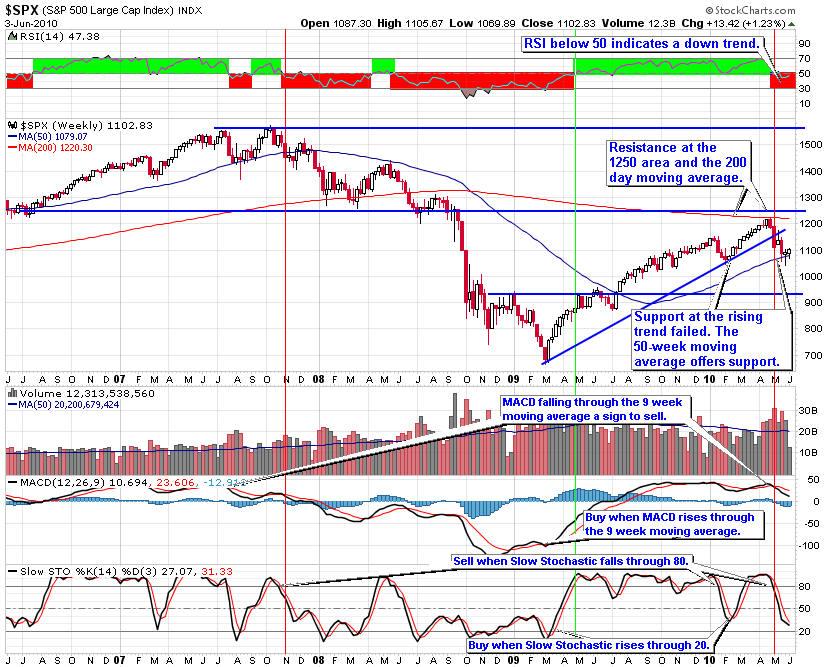S&P 500 Stock Market Trends Forecast for June 2010
Stock-Markets / Stock Markets 2010 Jun 09, 2010 - 09:50 AM GMTBy: Hans_Wagner
 This is a monthly chart for the S&P 500 showing 20 years of performance. Since this index is the one used by professional traders, it is important to understand how it is performing. This chart is also excellent at defining the longer-term trends for the market.
This is a monthly chart for the S&P 500 showing 20 years of performance. Since this index is the one used by professional traders, it is important to understand how it is performing. This chart is also excellent at defining the longer-term trends for the market.
The end of the bear market and the stock market bottom came at the long term rising trend. Shortly after the monthly Slow Stochastic rose through 20 then the MACD rose through its 9-month moving average. Finally, the RSI climbed through the 50 level, though it is testing this bull-bear market indicator now. Most recently, the S&P 500 crossed through the 24-month exponential moving average. As long as it remains above this level, a bull market is in place.
In early May 2010, the market pulled back as it tests the breakout through the 24-month exponential moving average. Monitor whether the 24-month EMA holds as support in the next month.
The RSI is below 50, a sign of a downtrend, though it is close to the 50 level. The MACD is trending up. Monitor how it handles the zero level to get an idea of the strength of this move. The Slow Stochastic is trending up as it pushes through the 50 level, a potential resistance area.
From a monthly chart perspective, the rally remains in tact as the 24-month EMA is still acting as support and the indicators have not turned negative.
For now, I intend to invest as though we are in a more normal market that will see rallies and then pullbacks. The rally of the last 12 months came as a rebound from an oversold condition as investors feared the worse. Going forward, we will experience market rallies and pull backs as the economy struggles to expand. The overall trend will be sideways in a range of 930 on the low and 1,250 at the high.
Big Picture S&P 500

The four-year weekly S&P 500 trend chart shows that the drop in the market that began in early May 2010. There is support at the 50-week moving average that has held, so far.
RSI is below 50, a sign of a downtrend. The MACD has reached a high point where it turned down through the 9-week moving average, giving a sell sign. The Slow Stochastic fell through 80, a sell sign and it is approaching 20.
The weekly chart pattern indicates the S&P 500 turned down, though it might be finding support at the 50-week moving average. If it holds, it is a good buying opportunity. Otherwise, expect another move down to the 930 level.
S&P 500 Weekly Chart

On the daily chart of the S&P, the index broke through support of the rising trend, the 50-day moving average and the 1,150 level. The 200-day moving averages also failed as support. It will act as resistance on the way up.
RSI is below 50 indicating a downtrend. The MACD is turning up through the 9-day moving average, giving a buy sign. The Slow Stochastic rose through 20 giving another buy sign.
The 150-day moving average is an excellent indicator of the longer-term trend for the market. When the slope of the 150-day moving average is positive (trending up) it means the market trend is up. Should the slope of the 150-day moving average become negative (trend down) the market is trending down. At this time, the 150-day moving average is flat. Should it turn down, it will tell us the market is trending down.
The daily chart of the S&P 500 is trying to push through resistance at the 200-day moving average. If it can regain this level, it will be a positive sign for the markets.
For 2010, I am expecting the market to trade in a range 1,250 area as the high 930 as the low.
S&P 500 Daily Chart

Given this analysis of the S&P 500 trend line charts, it is important to position your portfolio for a market that is more likely to trend in a range with cyclical rallies and pullbacks.
Selecting the right sectors and stock picking will become more important to your success. Look to buy on dips in the market to important support levels. Then add down side protection at interim high points using trailing stops and protective put options to help improve the overall return.
The charts of the S&P 500 trend lines provide a good way for investors to align their portfolios with the overall market trends. Picking the right sectors and stocks will become even more important. Look to buy on dips in the price of the S&P 500 trend charts on the next pull back.
Be sure to use proper capital management techniques including trailing stops, protective put, covered call options and position sizing. When the pull back ends, look to add to long positions with stocks and ETFs from the sectors that are likely to outperform the overall market. Keep in mind, Warren Buffett's first rule of investing is to not lose money. Be patient waiting for good entry points.
By Hans Wagner
tradingonlinemarkets.com
My Name is Hans Wagner and as a long time investor, I was fortunate to retire at 55. I believe you can employ simple investment principles to find and evaluate companies before committing one's hard earned money. Recently, after my children and their friends graduated from college, I found my self helping them to learn about the stock market and investing in stocks. As a result I created a website that provides a growing set of information on many investing topics along with sample portfolios that consistently beat the market at http://www.tradingonlinemarkets.com/
Copyright © 2010 Hans Wagner
If you wish to learn more on evaluating the market cycles, I suggest you read:
Ahead of the Curve: A Commonsense Guide to Forecasting Business and Market Cycles by Joe Ellis is an excellent book on how to predict macro moves of the market.
Unexpected Returns: Understanding Secular Stock Market Cycles by Ed Easterling. One of the best, easy-to-read, study of stock market cycles of which I know.
The Disciplined Trader: Developing Winning Attitudes by Mark Douglas. Controlling ones attitudes and emotions are crucial if you are to be a successful trader.
© 2005-2022 http://www.MarketOracle.co.uk - The Market Oracle is a FREE Daily Financial Markets Analysis & Forecasting online publication.



